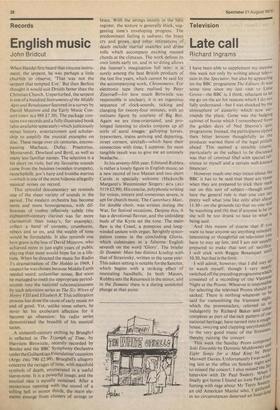Records
English music
John Bridcut
When Handel first heard that sinuous instrument, the serpent, he was perhaps a little churlish to observe, 'That was not the serpent that tempted Eve.' But then Berlioz thought it would suit Druids better than the Christian Church. Unperturbed, the serpent is one of a hundred Instruments of the Middle Ages and Renaissance featured in a survey by David Munrow and the Early Music Consort (Hmv st_s 988 £7.30). The package contains two records and a fully illustrated book (also available separately) which judiciously mixes history, entertainment and scholarship to amplify the musical examples on disc. These range over six centuries, encompassing Machaut, Dufay, Praetorius, Monteverdi, Dowland and Byrd, as well as many less familiar names. The selection is a bit short on viols, but my favourite sounds came from the buisines (wooden trumpets), rauschpfeife. jew's harp and tromba marina —which is one of the most hideous allegedly musical noises on record.
This splendid documentary set reminds one of the sheer variety of sounds in the period. The modern orchestra has become more and more homogeneous, with differences of timbre relatively subtle ((he eighteenth-century clarinet was far more clarinettish than today's, for example); collect a band of cornetts, crumhorns, rebecs and so on, and the wealth of tone would be formidable. It also reminds one how grave is the loss of David Munrow, who achieved more in just eight years of public playing than most would hope for in a lifetime. When he directed the music for Radio 3's dramatisation of The Hobbit in 1969, I suspect he was chosen because Middle Earth needed weird, unfamiliar noises. But soon he managed to instil the appropriate periodsounds into the national subconsciousness by such television series as The Six Wives of Henry VIII and Elizabeth R. This infiltration process has done the cause of early music no end of good. Yet, unlike some others, he never let his exuberant affection for it become an obsession: his radio series demonstrated the breadth of his musical tastes.
A sixteenth-century etching by Brueghd is reflected in The Triumph of Time, by Harrison Birtwistle, recently recorded by Boulez and the BBC Symphony Orchestra under theGul benkian Foundation'sauspices (Argo ZRG 790 £2.99). Brueghel's allegory concerns the ravages of time, with manifold symbols of death, enumerated in a useful sleeve-note. It is a powerful image, and the musical idea is equally sustained. After a mysterious opening with the sound of a tolling bell in minor thirds, the main elements emerge from clusters of strings or
brass. With the strings mostly in the fia.; '
register, the texture is generally thick, sugTelevision
gesting time's enveloping progress. The predominant feeling is sadness; the brass cry and groan, and other intimations of death include martial snatches and drum rolls which accompany exciting massed chords at the climaxes. The work defines its own limits early on, and in so doing allows the listener's imagination full rein: it is surely among the best British products of the last five years, which cannot be said for the accompanying work, Chronometer. For electronic tape (here realised by Peter Zinovieff—for how much Birtwistle was responsible is unclear), it is an ingenious sequence of clock-sounds, ticking and clanging for twenty-four minutes, with an ostinato figure by courtesy of Big Ben. Again we are time-orientated, and prolonged listening to clocks conjures up all sorts of aural images: galloping horses, typewriters, trains arriving and departing, street corners, aircraft—which have their connection with time, I suppose. Its most tangible result was to give me an untimely headache.
In his seventy-fifth year, Edmund Rubbra is rather a lonely figure in English music, so a new record of two Masses and two short Carols is specially welcome (Hickox/St Margaret's Westminster Singers: RCA LRLI 5119 £2.99). His concise, polyphonic writing for voices, sincere and sometimes severe, is apt for church music. The Canterbury Mass, for double choir, was written during the War, for festival occasions. Despite this, it has a devotional flavour, and the unfolding buds of the Kyrie set the tone. The main flaw is the Creed, a pompous and longwinded unison with organ. Sprightly syncopation comes in the concluding Gloria, which culminates in a fulsome English seventh on the word 'Glory'. The briefer St Dominic Mass has distinct kinship with that of Stravinsky, written in the same year. This oaken setting is notable for the Sanctus, which begins with a striking effect of resonating handbells. In both Masses. Rubbra sets the Resurrexit in the minor, and in the Dominic there is a daring semitonal plunge at that point.


































 Previous page
Previous page